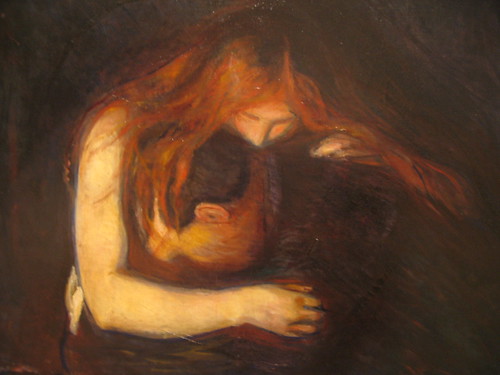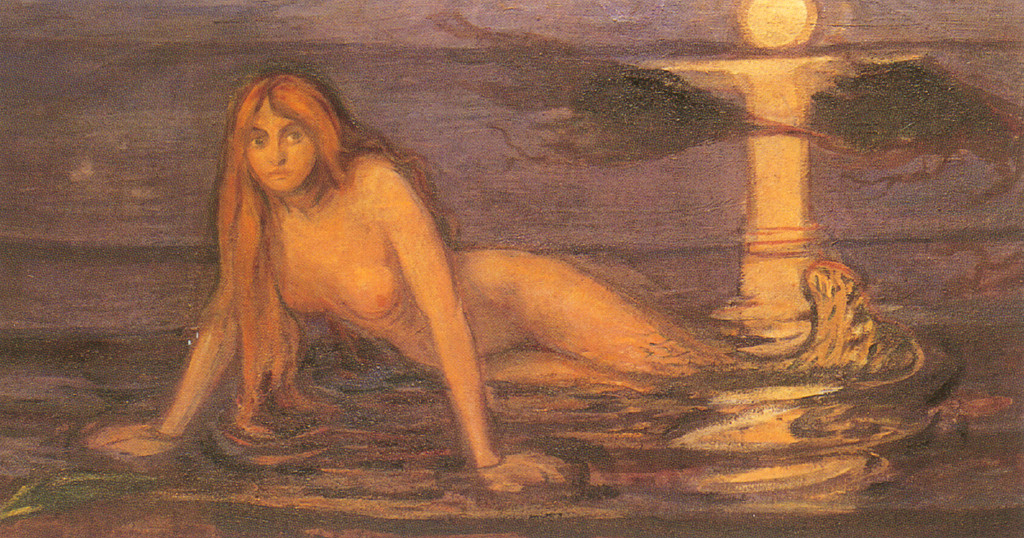迷失畫廊
逛畫廊,看世界, 記下自己的心得
Shrick 呐喊

Madona

The sick child , Tate, London

One of several versions of the print "The Lonely Ones". The Munch Museet, Oslo, Norway.
Puberty 青春期

Sensous Vampires Kiss
The Kiss
愛德華·蒙克(Edvard Munch,1863年12月12日-1944年1月23日),挪威表現主義畫家和版畫複製匠。他對心理苦悶的強烈的,呼喚式的處理手法對20世紀初德國表現主義的成長起了主要的影響。
生平
童年
蒙克,1863年12月12日出生於挪威雷登(Løten),在克裏斯蒂安尼亞(現在的奧斯陸)長大。是畫家雅各布·蒙克(Jacob Munch)和曆史學家彼得·安德烈·蒙克(Peter Andreas Munch)的親戚。蒙克的母親勞拉(Laura Cathrine Bjølstad)在1868年死於肺結核,母親過世後年幼的蒙克由父親單獨撫養。其父患有精神疾病,他向孩子們灌輸了對地獄根深蒂固的恐懼觀念,他一再告訴孩子,如果他們在任何情況下以任何方式犯罪,就會注定被投入地獄,沒有任何寬恕的機會。
父親在蒙克青年期去世(1889年),另一個兄弟和蒙克最喜歡的姐姐蘇菲在1877年也死了。蒙克的一個妹妹在小時候就被診斷出患有精神病,蒙克自己也是體弱多病。在五個兄弟姐妹中,隻有兄弟安德烈結過婚,但婚後不過數月也過世了。眼見雙親和手足接二連三地死去,嚴重打擊了蒙克的精神與情緒,接踵而至的悲傷對其是深度的精神折磨。因此,死亡烙印在他年輕而敏感的心靈深處,這大概就是為什麽蒙克的作品呈現壓抑且悲觀的原因。蒙克在晚年說到:“病魔、瘋狂和死亡是圍繞我搖籃的天使,且持續的伴隨我一生。”
青年時期
1879年,蒙克為了成為工程師而進入工學院念書。然而身體的健康不斷出現問題,讓他中斷了學業。1880年蒙克為了成為畫家而離開工學院。隔年他考進了奧斯陸皇家藝術和設計學院,他的老師是雕刻家朱利厄斯·米德爾頓(Julius Middelthun),以及自然主義畫家克裏斯蒂安·克羅格(Christian Krohg)。
1885年蒙克前往巴黎,他的作品也展現了自法國畫家處所受到的影響。一開始是印象派,接著是後期印象派,然後是新藝術造型。蒙克的繪畫盡管風格上是以後期印象派為主,但在主題上卻是象征派,其繪畫內容在於刻畫內心世界,而不是外在現實。
1892年蒙克應邀參加柏林藝術家聯盟在11月份舉行的畫展,他的繪畫也成了爭論的主題,為期一周的畫展結束後,蒙克待在柏林,成為一個多國人士參與的社交圈其中一員,這個圈子裏有作家、藝術家和評論家,包括挪威劇作家亨利克·易卜生(蒙克為易卜生的幾個劇本設計布景),以及瑞典戲劇家奧古斯特·斯特林堡。
1892年至1908年間,蒙克多數時間都在巴黎和柏林度過,他因銅版畫、石版畫和木版畫的表現成出名了。在世紀之交期間的柏林,蒙克開始用新的素材(照相、石版印刷和木版畫),憑著記憶來複製他過去的作品。1908年秋,他的焦慮變得更為深刻,開始在丹尼爾·賈可布遜博士的診所開始住院接受治療。醫院裏施行的休克療法改變了他的個性。
1909年,蒙克回到家鄉挪威,更多地表現出對大自然的興趣,他的作品變得更富於色彩,減少了悲觀的成分。在納粹統治期間,蒙克的作品被貼上了“頹廢藝術”的標簽,從德國的各個美術館被撤了下來。這對反納粹主義的蒙克來說是很傷心的,因為他把德國看作第二祖國。
晚年
蒙克在過完80歲生日後一個月的1944年1月23日,於奧斯陸附近的艾可利(Ekely)與世長辭。他捐贈了1000幅油畫、15400張版畫,4500件素描和水彩畫,還有6件雕刻作品給予奧斯陸當局。為了紀念蒙克,當局建造了“蒙克美術館”(位於Tøyen)。蒙克美術館是全世界收藏蒙克作品為數最多的美術館。
位於奧斯陸的國立藝術畫廊,收藏了蒙克的一些油畫作品。奧斯陸“大陸酒店”(Hotel Continental)裏的“Dagligstuen”酒吧則藏有不少蒙克的版畫精品。
畫風
在蒙克的畫家生涯中,他多次曾改變藝術風格。在1880年代,蒙克是自然派(比如《漢斯·耶格的肖像》)和半印象派(見《拉法耶特大街》)。1892年,蒙克樹立了具個人特色的綜合派原始畫風(比如《憂鬱》),在此色彩成為一種象征,亦是種具有承載功能的元素(比方說《呐喊》)。1890年代,蒙克傾向選擇景深較淺的作畫空間,他經常把畫中的人物安置在前台。
蒙克一直想表現人物的內心的心理狀態,出現在他畫中的人物呈現了最能表現這種狀態的姿勢(見《灰燼》),這種安排讓蒙克的畫帶來一種好像人物、空氣、記憶、動作和時間在一霎刹那間凝固的感覺,那也許正是人物內心活動達到頂峰的一瞬間。
蒙克所畫的人物,猶如舞台劇的各個角色(就像《病室裏的死亡》),很可能每種特定的姿勢就代表一種特定情緒,類似於某種身體語言。由於蒙克所畫的人物都承擔著表現一種特定心理狀態的使命(以《呐喊》為最有名),所以他創造的男人和女人不是現實的。蒙克堅稱,印象派並不適合於自己的藝術。他對描寫現實的任意一個斷麵也不感興趣,他要描寫的是那種充滿了情緒內涵的,且具有巨大的傳神力的狀態。為了達到這個目的,蒙克殫精竭慮地構思,他的作品創造了緊張氣氛。
代表作品
呐喊
《呐喊》(挪威語Skrik,也譯作《尖叫》,作於1893年),是蒙克最著名的代表作,被認為是存在主義中表現人類苦悶的偶像作品,和其他作品的慣例一樣,他一共畫了四個不同版本的《呐喊》。蒙克在世紀之交時期創作了交響樂式的《生命的飾帶》(The Frieze of Life)係列,《呐喊》屬於這個係列。這個係列涉及了生命、愛情、恐懼、死亡和憂鬱等主題。
蒙克通過這些主題來表現他切身經曆對生存和死亡的感受,比如《病中的孩子》(1886年,蒙克去世的姐姐蘇菲的肖像畫)、《病室裏的死亡》(1893年)、《絕望》(1893-1894年)、《吸血鬼》(1893-1894年)、《焦躁》(1894年)、《灰燼》(1894年)、《生命之舞》(1900年),每幅畫都強烈地傳達畫家的感覺和情緒,其描繪的對象的現實細節被簡化,而情緒則被誇張,對象本身成為一種要表現的情緒的載體,雖然它們依然還是具象的。這些畫具有永恒的震懾心靈的力量,在這一切的背後,觀賞者還可以看見“世紀末”的景象,那種迷途的欲望深淵和無法逃脫的死亡陰影的怪圈,生命的焦躁和無奈交織在一起。
蒙克作品的驚人表現,力量是來自於對藝術家內心世界不加掩飾的忠實表達,蒙克的畫是用整個心靈創作的。在1889年26歲的蒙克就寫道:“我們將不再畫那些在室內讀報的男人和織毛線的女人,我們應該畫那些活著的人。他們呼吸、有感覺、遭受痛苦並且相愛。”
生命的飾帶
1893年12月,蒙克在柏林著名的菩提樹下大街開畫展。和其它作品一起,蒙克出展了題為“愛的研究係列”,由六幅畫所組成。這是他此後命名為“生命的飾帶”組畫的起點。它包括深深地沉浸於大氣的主題:《風暴》、《月光》和《星夜》。其它主題有揭示愛的陰暗麵的,比如《玫瑰與阿美莉》和《吸血鬼》。《病室裏的死亡》則以死亡為主題,基於蒙克對姐姐蘇菲之死的回憶。在這幅畫中,蒙克的全家都在到,畫麵的焦點聚集在蒙克的背影上。1894年,“生命的飾帶”加進了《焦躁》、《灰燼》、《聖母》(Madonna)和《女人三階段》作品集。在世紀之交之際,蒙克完成了他的“生命的飾帶”組畫係列。
蒙克的作品有不少,其中一部分反映了當時新藝術(art nouveau)的美學思潮。1898年,蒙克專為他的大型繪畫《新陳代謝》(最初名為《亞當和夏娃》)做了一個帶有浮雕裝飾的精致的木製框架,這顯露了蒙克對“人類的墮落”神話的偏愛和他在戀愛方麵的悲觀哲學。《空的十字架》和《受難之地》(Golgota)都作於1900年,既反映了當時的形而上學的傾向,又是蒙克幼年時代的虔誠心的反照。“生命的飾帶”的第一次完整展出是在1902年柏林分離派畫展上。
(wiki)
List of major works
- 1892 - Evening on Karl Johan
- 1893 - The Scream
- 1894 - Ashes
- 1894-1895 - Madonna
- 1895 - Puberty
- 1895 - Self-Portrait with Burning Cigarette
- 1895 - Death in the Sickroom
- 1899-1900 - The Dance of Life
- 1899-1900 - The Dead Mother
- 1940-1942 - Self Portrait: Between Clock and Bed
Gallery
The Scream. 1893. Oil, tempera, and pastel on cardboard. Nasjonalgalleriet, Oslo. | Death in the Sickroom. c. 1895. Oil on canvas. 59 x 66 in. Nasjonalgalleriet, Oslo. | The Dance of Life. 1899–1900. Oil on canvas, 49½ x 75 in. Nasjonalgalleriet, Oslo. | Madonna. 1894-95. Oil on canvas. 36 x 28 in. Nasjonalgalleriet, Oslo. |
Vampire. 1893-94. Oil on canvas. Nasjonalgalleriet, Oslo. | Ashes. 1894. Oil on canvas. 120.5 x 141 cm. Nasjonalgalleriet, Oslo. | The Sick Child (1885-87). Tate Gallery, London. | |
August Strindberg. 1892. Oil on canvas, 120 x 90 cm. Museum of Modern Art, Stockholm, Sweden |

‘I was out walking with two friends. The sun began to set. Suddenly the sky turned blood red. I paused, feeling exhausted, and leaned on the fence. There was blood and tongues of fire above the blue black fjord and the city. My friends walked on and I stood there trembling with anxiety, as I sensed an infinite scream passing through nature.’
The Scream, Edvard Munch’s most dramatic and important work, is a potent symbol of terror, but terror of what; an existential loneliness? – the death of God? – the meaninglessness of materialism? Whatever, Munch projects this unbearable dread and isolation into this painting.
But artists always project their innermost feelings into their work. All creative people do. So why was Munch so anguished? Was it the death of his mother from TB, the combination of love and fear he felt for his father, the death of his older sister from the same dread disease, his own brush with death, or his feelings of guilt and devastation from two failed love affairs? That’s enough trauma for anybody, particularly one as sensitive as Edvard Munch. Love and death dominate his work, but representations of love were never joyous; they were always linked in his art with threat and death. And it was his experience of home and family that provided the inspiration for his creative expression.
As he wrote, ‘When I cast off on the voyage of my life, I felt like a ship made of old, rotten material sent out into a stormy sea by its maker with the words. If you are wrecked, it’s your own fault and you will be burnt in the eternal fires of hell.’ Not the most inspiring message to set sail on.
Edvard Munch came from the bourgeois suburb of Christiania, just outside Oslo, a society redolent of protestant hypocrisy. The state controlled brothels were regularly inspected to ensure that their upright clients did not take VD back to their protestant wives. But the Munches were more bohemian; middle- class priests, scholars, artists and poets with elements of genius and degeneration. His father was an impoverished army doctor. His wife, Laura, was one of his patients and half his age, but she shared the same deep religious convictions. They had five children in seven years but it exhausted Laura. She died of TB when Edvard was just 5. Karen, Laura’s sister, brought a breath of fresh air into the family home. It was she who encouraged Edvard to draw. By the age of 12, he was spending many hours a day drawing. But Edvard’s father was not consoled by Karen; he sank into his own introspections and used to frighten the children with stories of Edgar Allen Poe and warnings that their mother was watching them. Edvard suffered from nightmares and nearly died of TB when he was 13, and the following year his elder sister, Johanna died.
But Edvard found solace in drawing and painting and confidence in his success. At 22 he exhibited his work at the World Fair in Antwerp and was embarking on an affair with a married woman. ‘Young and inexperienced from a monastery like home, knowing nothing of this mystery, I met a salon lady and stood before the mystery of women.’ No doubt this ‘education’ informed his depictions of women as vampires, creatures that would seduce, tempt and destroy men. ‘Behind the prettiness lies death; the medusa’s head.’ Whereas Ibsen was writing about the entrapment of women by marriage, Munch saw men as the victims.
In 1889 he went to Paris, where he came into contact with the Impressionists, but it was Van Gogh’s suicide that probably had the greatest impact on him. The shock opened up a space in Edvard’s painting. He came to believe that painting should not just be about representation, it should express those feelings, emotions, states that you couldn’t see.
‘People will understand what is sacred in them and will take off their hats as if in church I shall paint living people who breathe and feel and suffer and love’.
In 1892, Munch was invited to exhibit his paintings in Berlin, but his exhibition upset the sensibilities of the narrative, romantic style of German art. Munch painted it as it was. His Frieze of Life, depicted the trajectory of a love affair through the kiss, love, pain, jealousy, betrayal and despair. Painting for Munch did not express one moment, but could, like a poem or a novel, illustrate an unfolding narrative. The exhibition was withdrawn after a week. This pleased the entrepreneur in Munch immensely as he realised that the negative publicity would do him nothing but good.
But appeals to his darker needs were never far away. His relationship with Tulla Larson, the 30 year old unmarried daughter of a rich wine merchant was one from which neither would ever recover. He was shocked and frightened by the strength of Tulla’s passion. He expressed his regret that this on-off affair has robbed him of 3 years of creative life and the use of his left hand, which was wounded when his pistol was accidentally discharged during their final argument. Bereft and traumatised, he threw himself into excesses of work, drink and gambling. He became ill, paranoid, developed hallucinations and in 1908 broke down and was admitted to Dr Jacobsen’s clinic. In time, he recovered and carried on working until his death in 1944, though some said that the life, the intensity had gone out of his work.
Before I knew anything about Munch, I was using his images to illustrate my talks on the bodily expression of human emotion. His expressive paintings capture the anguish of emotion more clearly than any other artist I know. He was a man on a mission, a mission to discover meaning through the depiction of love, fear,melancholia and death. He believed that you had to spill your guts for art. So Munch made art from his life, his depressed sick childhood, the deaths of his mother and sister, his morbidly introspective father, his tortured romances. He marketed the flaws in his personality for people to recognise and identify with. He offended people, of course. Even Adolf Hitler regarded his work as degenerate art. With such enemies, however, he had no need of friends. His legacy was assured. His emotionally charged landscapes had launched the German expressionist movement while his ability to get under the skin to the raw bleeding core of his subjects inspired such contemporary masters as Frances Bacon and Lucian Freud.
Schopenhauer once wrote, ‘The limit of the power of art is its inability to reproduce a scream.’ Perhaps Munch wished to show him his error.














